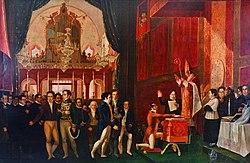| Regency period | |||
|---|---|---|---|
| 1831–1840 | |||
 The oath of the provisional triumviral regents in the Imperial Chapel, painting by Manuel de Araújo Porto-Alegre | |||
| Key events | Abdication of Pedro I Declaration of age of Pedro II | ||
Chronology
| |||
| Part of a series on the |
| History of Brazil |
|---|
 |
|
|
The regency period is how the decade from 1831 to 1840 became known in the history of the Empire of Brazil, between the abdication of Emperor Pedro I, on 7 April 1831, and the declaration of majority of Pedro II, who was legally declared of age by the Senate at the age of 14 on 23 July 1840.
Born on 2 December 1825, Pedro II was, at the time of his father's abdication, 5 years and 4 months old, and therefore could not assume the government which, by law, would be headed by a regency made up of three representatives. During this decade there were four regencies: the Provisional Triumviral, the Permanent Triumviral, the una (sole) of Diogo Antônio Feijó and the una of Pedro de Araújo Lima.
It was one of the most defining and eventful periods in Brazilian history; in this period the territorial unity of the country was established and the Armed Forces were structured. In addition, it was also the period when the degree of autonomy of the provinces and the centralization of power was discussed.
During the regency, a series of local provincial rebellions erupted all over Brazil, such as the Cabanagem, in Grão-Pará, the Balaiada in Maranhão, the Sabinada, in Bahia, and the Ragamuffin War, in Rio Grande do Sul, the latter being the largest and longest. These revolts threatened to disintegrate the country and showed the growing discontent with the central power and the latent social tensions of the newly independent nation, which prompted the joint effort of their opponents and the central government to maintain order. Historians have remarked that the regency period was the first republican experience in Brazil, given its elective nature.[1]